| Author |
 Topic Topic  |
| Reply #1
Stargazer 40
    
USA
431 Posts |
 Posted - 09/05/2018 : 05:50:36 Posted - 09/05/2018 : 05:50:36


|
quote:
Originally posted by ullix
The tubes' specs all state a need for an anode resistor. This may have to do with the early power supplies potentially delivering more power than needed, and the resistors limited current flow so the tubes won't light up as light bulbs.
Well, it remains a requirement with modern power supplies as well as all of the LND detectors specify it as a necessary part of the system (10 Mohm).
Perhaps a better way to say it is as ZLM did above. We want the measure of the PS ability to support the tube's voltage requirements for plateau range. We don't need or want to average in dead time and at recovery point the BC approach better shows that given the samplings limitations/averaging of our meters. |
Stargazer 40 |
Edited by - Stargazer 40 on 09/05/2018 05:51:17 |
 |
|
| Reply #2
Stargazer 40
    
USA
431 Posts |
 Posted - 09/07/2018 : 03:24:25 Posted - 09/07/2018 : 03:24:25


|
| @ZLM, what is the date of your source? Looks like Apr 2010? |
Stargazer 40 |
 |
|
| Reply #3
EmfDev
    
2375 Posts |
 Posted - 09/07/2018 : 09:18:49 Posted - 09/07/2018 : 09:18:49


|
| From video. it shows Apr 2011. |
 |
|
| Reply #4
Stargazer 40
    
USA
431 Posts |
 Posted - 09/07/2018 : 14:58:23 Posted - 09/07/2018 : 14:58:23


|
| Thanks EmfDef. It wasn't all that clear. I have ordered one of these 5 uCi sources and hopefully it will be dated middle of 2018. About a quarter of half life between the two so should see higher counts. In addition, I will test both tubes at the top or near the top of their plateau voltages (440V) to settle in my own mind how much I will gain from voltage tweaks. It will give us two points of control in addition to those provided by ZLM in videos. |
Stargazer 40 |
 |
|
| Reply #5
ikerrg
    
United Kingdom
334 Posts |
 Posted - 09/08/2018 : 10:45:26 Posted - 09/08/2018 : 10:45:26


|
I am a bit jealous, Stargazer 40, that you can freely buy Cs-137 sources in the States! I cannot find them here in Europe, and I think ullix said somewhere that you need a license to own one, so the idea of buying it in the States and bringing it back would be against the law.
|
 |
|
| Reply #6
Stargazer 40
    
USA
431 Posts |
 Posted - 09/08/2018 : 18:57:56 Posted - 09/08/2018 : 18:57:56


|
I think for educational items like this they are perfectly legal here without administrative burden on my end, but there is a limit on activity and what you can send in the post or ship. You can buy a number of source types including Polonium and Cobalt. Limit is 10 uCi per source I believe, and they sell them in lead holders of up to eight. Pretty large price to pay for variety though, and I was looking for a similar comparison with GQ's.
Even these carry a degree of responsibility for proper storage and use. I don't plan on handling this directly, and will limit exposure with well planned experiments. My thorium mantles are kept isolated with the lanterns that also exhibit fairly good counts from their ashen counterparts mounted inside.
Cost for this is more than the meter but I do volunteer work with all hazard first responders and I don't want to be surprised because I don't know what I might be walking into. And it really is quite interesting to explore with both you and ullix, and of course the GQ guys. Reminds me of a 3rd semester nuclear physics lab course from many years ago. |
Stargazer 40 |
 |
|
| Reply #7
ullix
    
Germany
1235 Posts |
 Posted - 09/09/2018 : 02:00:13 Posted - 09/09/2018 : 02:00:13


|
The situation in the EU is significantly different.
First you need to certified to being able to handle such radioactive substances. Then you need permission for the shipment. And then you need to shell out some 700Ç to purchase a 10ÁCi Cs137 source (google for "PrŘfstrahler 6706").
And perhaps you want to buy a Geiger counter as used by the HazMat teams for 1500Ç ( https://www.gfd-katalog.com/schmitt_feuerwehrtechnik/dosisleistungs-messgeraete/14673 )
You can see in this brochure what a certified standard entails. Though in German, the pictures are telling. This is explicitly specified as a "gamma source". Given the mechanical design, I do believe that indeed no betas can be detected. Which of course will reduce the max counts you can get.
@Stargazer: if the source you get looks more like the one we could see in ZLMs video, I suggest to check with beta absorbers what type of radiation you see!
Where did the link to the brochure go? here again: https://www.automess.de/Download/Prospekt_6706_D.pdf
|
Edited by - ullix on 09/09/2018 05:06:38 |
 |
|
| Reply #8
Stargazer 40
    
USA
431 Posts |
 Posted - 09/09/2018 : 04:27:12 Posted - 09/09/2018 : 04:27:12


|
ullix, Thanks for sharing that website. Automess has been making dosemeters since 1970 I think and they are available here in US. They have some features that I think allow them to be considered professional meters, and that GQ should consider if they want to get into that market (I for one think they are not all that far away). The cases are made out of aluminum for added durability. They allow for a variety of probes to simply be plugged in (PTB approved, whatever standard that is). The 6150AD-t Teletector Probe is a dual tube external probe with the same idea behind it as the 500+ - low and high sensitivity tubes selectable. When it is plugged in, the tube in the 6150AD-6e is disconnected. External probes support cable lengths up to 100m (not sure if that is power drain on meter or self powered, but likely the latter). And similar to the Mazur series of detectors (~$600 USD) I've mentioned before, they are independently calibrated across the entire range. This 6150AD meter only comes with two ranges available - .01 uSv/h- 10 uSv/h and .1 uSv/h-1 Sv/h. Not indicated, but perhaps the external probe contains both tubes in one package.
I think for a highly portable personal dosemeter with built in tube, the Mazar 9000 is likely the closest US made meter fitting that purpose. If GQ wants to compete there, they can do so with the 500/600 series, simply by making a few changes to the hardware and having the devices independently calibrated. For the 500+, add the switch to turn off the low sensitivity tube; for 500/600 series meters, have them calibrated and provide independent calibration report for the design. Consider adding an aluminum case for durability. The 600+ already uses the gold standard LND 7317 pancake tube just like the Mazur 9000. The 600 uses the SBT-11 pancake, so perhaps not the choice of professionals for a personal meter. Mazur 7000 and 8000 meters use LND 713 and 712 tubes respectively. They are less sensitive, but the top of calibration measurement range is still only 5,000 uSv/h. I very much like the idea of the 600+ with its 7317 pancake tube in the case with an external wand with LND 712 end window tube for high and low sensitivity alpha, beta, gamma and xray measures. Put it all together in an aluminum case and add independent calibration and sounds like perfect meter for what we've been talking around here. Also, with the 712 lower sensitivity tube added to the 600+ GQ wouldn't have to boost the PS capability; only switch to 712 tube and carry on.
I also think the 6150AD meter is shielded for betas as it is described as a gamma/xray dosimeter only.
The source I am getting is pretty much exactly the same as ZLM's. Although marketed by various companies, they are manufactured and shipped by a company called Nucleus. One inch plastic disks with beta/gamma sources molded inside for safety. If alpha sources are added they are windowed somehow. Energies emitted by this source are:
Primary Radiation Type(s)
Gamma (#947;) & Beta (#946;)
Energies KeV
#947;: 32, 661.6
#946;: 511.6, 1173.2
I do plan on doing the beta blocking experiment to see what percentage is gamma versus betas. |
Stargazer 40 |
Edited by - Stargazer 40 on 09/09/2018 05:11:31 |
 |
|
| Reply #9
ikerrg
    
United Kingdom
334 Posts |
 Posted - 09/09/2018 : 08:05:57 Posted - 09/09/2018 : 08:05:57


|
I don't think you can obtain the percentage between beta and gamma in the source by using the GM tubes because the sensitivities of the tubes to both radiation types are different and unknown. But you can obtain the ratio between the sensitivities of the M4011 and SI-3BG tubes in the same gamma radiation by using the beta blocking metal sheets. I suppose that the 32 keV gammas are also going to be shielded by the metal sheets, so you will be able to measure only the 661.6 keV gammas.
I have found a website where you can purchase gamma only sources, again only in the US: h**p://unitednuclear.com/index.php?main_page=product_info&products_id=819
|
 |
|
| Reply #10
Stargazer 40
    
USA
431 Posts |
 Posted - 09/09/2018 : 10:15:16 Posted - 09/09/2018 : 10:15:16


|
quote:
Originally posted by ikerrg
I have found a website where you can purchase gamma only sources, again only in the US: h**p://unitednuclear.com/index.php?main_page=product_info&products_id=819
Yes, this is the company that makes the sources. All those available whether gamma, beta or alpha are also available at Images IS where I ordered mine from. There is a cost difference and Images IS was actually cheaper per source disk. However they doubled the shipping cost after I checked out and notified me of the difference that had to be paid. Also the United Nuclear site says it takes 7-9 days to make the disks and I didn't get that information from Images SI when I ordered, only that it might take three days to process. So I have an email into them to see when this disk might finally ship. So we not only can order them, but have multiple sites to do some from so actually some competition out there controlling prices.
ullix, what is the best pure gamma source if there is such a thing. I thought it might be Cobalt 57, but still some betas and those gammas are lower energy I think. |
Stargazer 40 |
 |
|
| Reply #11
ikerrg
    
United Kingdom
334 Posts |
 Posted - 09/09/2018 : 10:19:57 Posted - 09/09/2018 : 10:19:57


|
| Cobalt 60 looks very good (https://en.wikipedia.org/wiki/Cobalt-60), as most of the betas are very low energy and very easy to shield, and the gammas are very high energy (almost as high as Potassium 40). However, the half life is only about 5 years, so the investment in a source does not last very long. |
Edited by - ikerrg on 09/09/2018 10:20:21 |
 |
|
| Reply #12
Stargazer 40
    
USA
431 Posts |
 Posted - 09/09/2018 : 10:43:21 Posted - 09/09/2018 : 10:43:21


|
| Well, It's 'only' $82 USD and if ordered with a second different source shipping may not be too bad. So if you're trying meters and seeing how they work it probably is worth it. Get it done in a month or so and you're in good shape. |
Stargazer 40 |
Edited by - Stargazer 40 on 09/09/2018 10:43:52 |
 |
|
| Reply #13
ullix
    
Germany
1235 Posts |
 Posted - 09/10/2018 : 01:13:03 Posted - 09/10/2018 : 01:13:03


|
The perfect gamma source? An X-ray machine. Better yet, an accelerator of some kind.
Given that us normal mortals won't have access to anything like that, we have to settle for the imperfect stuff. For the US this list might show what is available: https://www.imagesco.com/geiger/radioactive-sources.html I find this list quite helpful
Exclude the alpha emitter.
Exclude those listed as beta emitter. While they may emit gamma also, this can be assumed to be the lesser activity.
Exclude everything which has gamma below the specified (whatever the value of those dubious spec sheets is) lower detection limit of the M4011, which is 100keV. This excludes Cd109, and I would add Co57, being marginally above 100keV.
Ba133 is supposedly gamma only, yet here h**p://www.spectrumtechniques.com/products/sources/ba-133/ they claim betas from B133. (seems strange, though, as gamma is from electron capture). Nevertheless, one should make the assumption that all those sources have both beta and gamma, and we use shielding to select for gamma only.
The good news is that for these kind of sources you have a rather clear situation, not as confusing as all the decay chains from Uranium and friends.
And pick the highest activity available (or you can afford), given that the betas will be excluded anyway and thus reduce activity available for experiments. Setting the min limit at 10ÁCi, this leaves:
Ba133: low energy (~300keV)
Cs137: medium energy (660keV)
Mn54: medium energy (800keV)
Na22: medium and high energy (511, 1300 keV)
Alternatives but only available at 1ÁCi:
Co60: high energy (~1300keV)
Zn65: medium and high energy ( 511, 1100keV - 0.6a half live)
the 511keV line is from positron annihilation and generally dominates the spectrum.
To cover the whole energy range you end up with the classic Cs137 plus Co60, complemented with Ba133.
One interesting question: how is the activity determined? Let's take Cs137, which emits 1 beta, followed by 1 gamma, but from the daughter nuclei (not 100%, but close). Since it is declared Cs137, I would assume that only the betas are counted in the ÁCi. Since the German (EU) packaging absorbs the betas, while the US packaging allows them through, does a 10ÁCi US source have twice the activity as seen by a Geiger counter than a German 10ÁCi source? I found no specs on this question. Anybody knows?
|
 |
|
| Reply #14
Stargazer 40
    
USA
431 Posts |
 Posted - 09/10/2018 : 04:57:41 Posted - 09/10/2018 : 04:57:41


|
Thx ullix! Very complete analysis as usual. I think the C60 is the logical choice even though only a 1 uCi activity level. I see US packaging requiring lead shielding for betas for 10 uCi and greater. I ordered one of the two disk lead shield flat cases with my 5 uCi source. If I get more I will get the cylindrical pig that is a lot thicker and holds eight disks, but not thick enough to cut gamma emission in half.
Regarding your question, I think the sources are measured sans packaging. So sitting on the table in front of you the disk is emitting at 10 uCi whether German or US. |
Stargazer 40 |
 |
|
| Reply #15
ullix
    
Germany
1235 Posts |
 Posted - 09/10/2018 : 23:54:44 Posted - 09/10/2018 : 23:54:44


|
quote:
Regarding your question, I think the sources are measured sans packaging. So sitting on the table in front of you the disk is emitting at 10 uCi whether German or US.
Yes, but with a US source you get twice the counts as with a German source. I'll report this separately, because I think it is quite important!
|
 |
|
| Reply #16
ullix
    
Germany
1235 Posts |
 Posted - 09/11/2018 : 04:23:18 Posted - 09/11/2018 : 04:23:18


|
Blimey:
Read this website carefully: https://www.imagesco.com/geiger/radioactive-sources.html
Under the heading 'License free' near the top:
These are safe, uncalibrated solid sealed sources.
...
Contains 20% of the stated activity
You order 10ÁCi, and we will ship you 2ÁCi??????? Now, that is chutzpah!
|
 |
|
| Reply #17
Stargazer 40
    
USA
431 Posts |
 Posted - 09/11/2018 : 14:47:43 Posted - 09/11/2018 : 14:47:43


|
| I have enquired of their sales staff just exactly what does that 20% number mean with regard to activity. Should hear back tomorrow, Wed, 12th. |
Stargazer 40 |
 |
|
| Reply #18
ullix
    
Germany
1235 Posts |
 Posted - 09/11/2018 : 23:46:29 Posted - 09/11/2018 : 23:46:29


|
I emailed them already and they excused them saying that "a non-english person" had updated their web pages. Aha.
So now the text is changed and it says "Contains (+/-) 20% of the stated activity". Quite an uncertainty, and thus barely usable for calibration. But a comparably cheap source. |
 |
|
| Reply #19
ikerrg
    
United Kingdom
334 Posts |
 Posted - 09/12/2018 : 02:39:19 Posted - 09/12/2018 : 02:39:19


|
| That answer looks a bit pejorative. Being a non-native english speaker does not mean that you don't understand the difference between 20% and (+/-)20%! They should have answered that "an incompetent person" had updated their web pages. |
 |
|
| Reply #20
Stargazer 40
    
USA
431 Posts |
 Posted - 09/12/2018 : 04:29:20 Posted - 09/12/2018 : 04:29:20


|
quote:
Originally posted by ikerrg
That answer looks a bit pejorative. Being a non-native english speaker does not mean that you don't understand the difference between 20% and (+/-)20%! They should have answered that "an incompetent person" had updated their web pages.
 |
Stargazer 40 |
 |
|
| Reply #21
Stargazer 40
    
USA
431 Posts |
 Posted - 09/12/2018 : 16:14:23 Posted - 09/12/2018 : 16:14:23


|
Got my 5 uCi source today. It did not come from Michigan, but from Tennessee. A company I've gotten quotes from before. Spectrum Techniques is in Oak Ridge, Tenn.
It came in an 8"x8"x8" box with label saying it contained radioactive material excepted for shipment.
Inside was the flat plastic case with foam liner and two flat lead plates 1/8" thick with little pie plate punches to hold two disks.
Image Insert:
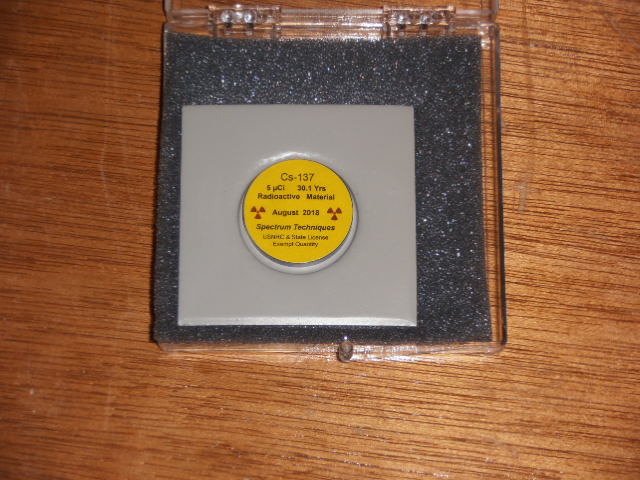
74287 bytes
The disk, like GQ's, only dated August 2018.
I thought it would be interesting to see just how much radiation made it through the lead. So put the 500+ with M4011 centered on the disk and recorded counts.
Image Insert:
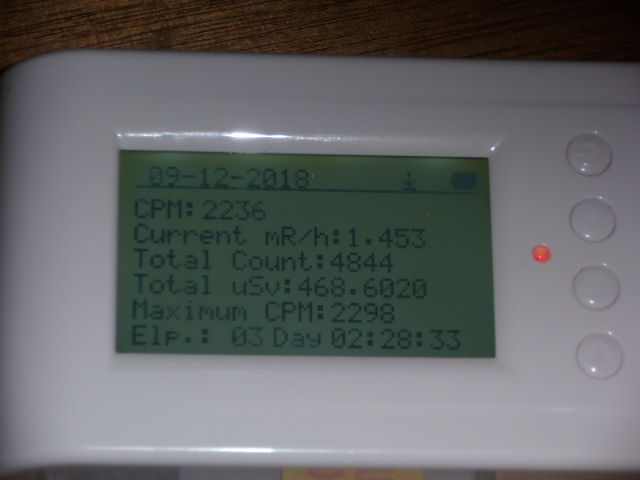
77507 bytes
Then switched to SI3BG and got this
Image Insert:
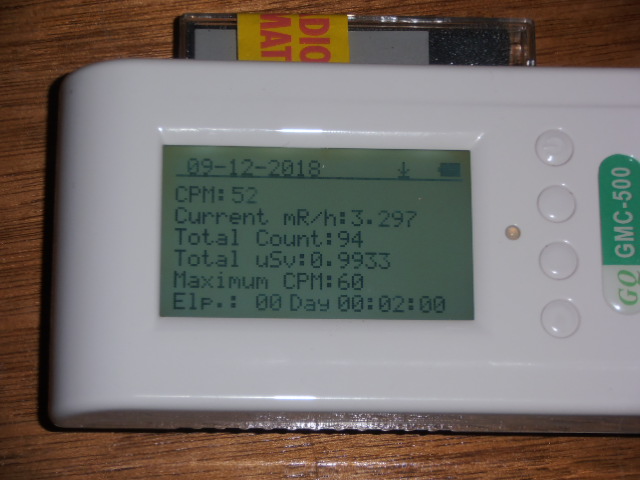
78017 bytes
Didn't have time to get voltage data or to remove from case so ran a couple of quick tests with the 500+ laying on the disk first with the M4011
Image Insert:

81049 bytes
and then the SI3BG
Image Insert:
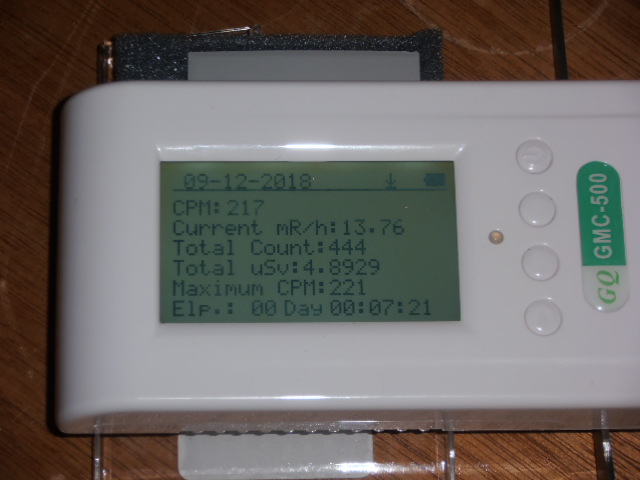
78987 bytes
And for fun I put the CD-V 700's wand into play with shield closed
Image Insert:

81769 bytes
and open
Image Insert:
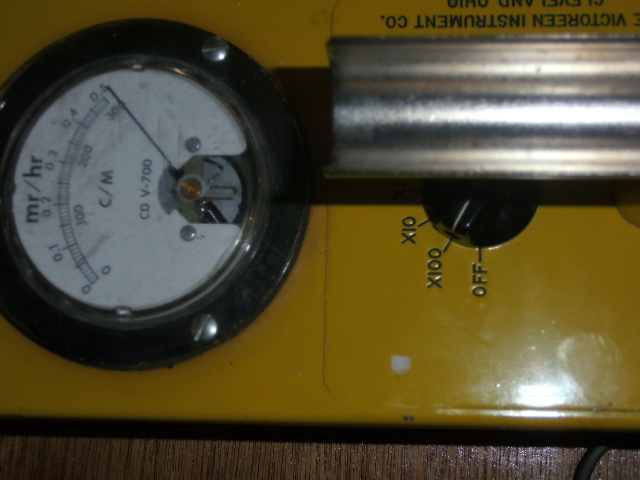
82179 bytes
That pegged the meter at 100X so more than 30,000 counts.
Lots more to do, but wanted to get some quick numbers to begin to play with when I have more time. |
Stargazer 40 |
 |
|
| Reply #22
ikerrg
    
United Kingdom
334 Posts |
 Posted - 09/13/2018 : 00:09:44 Posted - 09/13/2018 : 00:09:44


|
Nice! It seems that the 3 mm lead plates are shielding the beta completely, and probably many gamma. That is why the ratio between CPMs in the first test (43) is smaller than the ratio in the second test (127). It is interesting, because the ratio to gamma is much lower than what ullix measured from the Potassium-40 gammas. It might be that the energy of the gammas is also important for the sensitivity of each tube! In any case, this requires much more careful experimentation, using GeigerLog for longer recording times to be sure that the data makes sense.
Again, I am jealous that you can play with that source!
|
 |
|
| Reply #23
Stargazer 40
    
USA
431 Posts |
 Posted - 09/13/2018 : 04:45:02 Posted - 09/13/2018 : 04:45:02


|
According to table of half value layers, for a 500-keV gamma ray source it would take .42 cm of thickness to cut the gamma to 1/2 level. Cs137 emits mostly 662 keV so if we kick that up to .5cm and then reduce to 3mm we get 3/50 = .06, and that's times 50% = 3%. So gammas are only being cut by 3%. We can calculate counts for the gammas from this source by dividing 2236 CPM (M4011 tube) by .97 = 2305 CPM. If all betas are stopped by 3mm of lead, then gamma percentage of counts is 2305/27747 = ~8.3% of counts.
That alone is really nice to be able to come up with.
I tried the source with the CD-V 717 ionization chamber survey meter. I got pretty much nil response. Now I am wondering if the steel chamber walls are stopping the betas and what I thought it would see (3 chart divisions on .1X) now is only 8% of 3 chart divisions so only a quarter of division in the least sensitive part of the metering system. Still don't know if this meter is working okay. And it wouldn't really do to get a 10 uCi Cs137 source as only half a division. Better to spend $92 and have tested and calibrated with some meaningful gamma radiation at the main CD shop in Texas.
Lots more to come, and yes it is really nice to have this source to work with! |
Stargazer 40 |
Edited by - Stargazer 40 on 09/13/2018 04:46:13 |
 |
|
| Reply #24
Stargazer 40
    
USA
431 Posts |
 Posted - 09/13/2018 : 06:20:24 Posted - 09/13/2018 : 06:20:24


|
From a description of the CD-V 717 meter: 'The ionization chamber plus the instrument case will together total more than 1000 mg/cm2 in
effective thickness to make the instrument insensitive to beta rays lower than 2 Mev in energy.' So looks pretty much like a gamma only device. |
Stargazer 40 |
 |
|
| Reply #25
ikerrg
    
United Kingdom
334 Posts |
 Posted - 09/14/2018 : 11:13:45 Posted - 09/14/2018 : 11:13:45


|
I have just received a 1 GOhm resistor (by the way SMD type because it was much cheaper!) and I have measured the stock voltage of my GMC-500+. The DVM reading was 3.764 V, which corresponds to a voltage in the tube (with the DVM connected) of about 380.2 V, which should rise to 387.4 V when the DVM is disconnected (I used the internal resistance of the HV circuit given by ullix in this thread, i.e. 16.12 MOhm).
Image Insert:
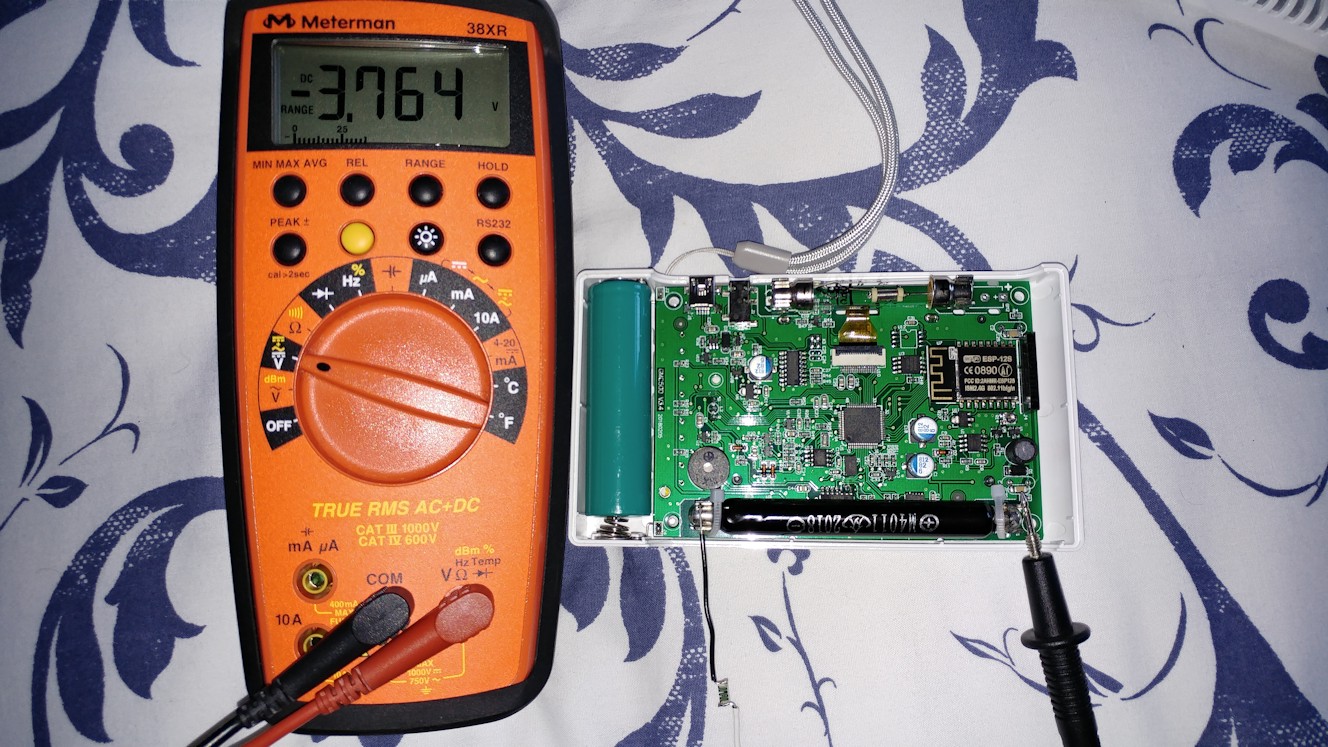
283532 bytes
I have changed the default voltage so the tubes are connected to a maximum of 415 V (when no counts are measured), to allow for some margin when high count rates reduce the voltage. That is equivalent to a DVM measured voltage of about 4.03 V.
Image Insert:

288146 bytes
I'll check if the measurements are still OK at the new voltage.
|
Edited by - ikerrg on 09/14/2018 11:14:22 |
 |
|
| Reply #26
Stargazer 40
    
USA
431 Posts |
 Posted - 09/14/2018 : 11:52:00 Posted - 09/14/2018 : 11:52:00


|
I set mine to 440V, which was the top of the plateau. The meter seems to be working fine.
|
Stargazer 40 |
 |
|
| Reply #27
ikerrg
    
United Kingdom
334 Posts |
 Posted - 09/14/2018 : 12:37:57 Posted - 09/14/2018 : 12:37:57


|
| Thanks for the info. I may increase it a bit more. |
 |
|
| Reply #28
Stargazer 40
    
USA
431 Posts |
 Posted - 10/13/2018 : 05:01:01 Posted - 10/13/2018 : 05:01:01


|
quote:
Originally posted by ullix
Calibration Factors
While the calibration factor of 0.0065 ÁSv/h/CPM for the 1st tube, the M4011, has been taken for granted (without any data ever presented to support this claim) the calibration factor for the 2nd tube, the SI3BG, remains elusive, even as a factor relative to the 1st tube.
All evidence available suggests that it is higher than the claimed 0.194 ÁSv/h/CPM, meaning its sensitivity is not only 30time less than the 1st tube, but 60, 100 or even 500 times less!
Actually in the sticky 'For those wishing to calibrate their unit' at the top of the forum list, Alchemy2 goes through calibration of the M4011 and SBT-11A tubes in his GMC-320+ meters in quite a lot of detail (including shielding for betas).
The average between the three types of sources he used (Cs137, Ba133, Co60) for the M4011 tube is 154.33 CPM over background and rounded to four decimal places is .0065 CPM/uSv/hr.
This appears to be a pretty good plan to follow if you have the sources. Still want to acquire the additional source types at 5 uCi levels, except Co60, which is only available at 1 uCi level and will go through this exercise, but since I do have the Cs137 already it will be straight forward to redo now for the single source.
As for the SI3BG tube I found specs at this site
h**ps://picclick.ca/NEW-SI-3-BG-SI3BG-CI3BG-192146574795.html
Gamma sensitivities of 1.13 - 1.41 CPM/uSv/h (these are same as ikerrg found using his Russian keyboard for the Russian spec sheet in the SI3BG thread) or
.709 - .885 for conversion factor to uSv/h. With an average of .797 the 25 CPM 3rd calibration point would be 19.93.
GQ, this is additional confirmed documented information on the SI3BG tube (and that fits much better data ullix, ikerrg and I have posted) and now should justify the change of conversion factor programmed by GQ as shipped from .194 up to something like .797 (M4011 is 123X more sensitive). It's a gamma sensitivity, but at levels the tube will be used at that's all that matters. The limit of measurement for the SI3BG tube is 300 R/h. That's well into Severe Radiation Sickness, Likely Fatal.
|
Stargazer 40 |
Edited by - Stargazer 40 on 10/14/2018 05:19:50 |
 |
|
| Reply #29
Damien68
    
France
780 Posts |
 Posted - 10/04/2019 : 09:00:45 Posted - 10/04/2019 : 09:00:45


|
The only voltage that counts towards the specifications of the tube is V(AC) (voltage between point A and Point C).
When the tube does not detect particles:
it's impedance is almost infinite. no current flows through it, it only equivalent to a capacitive load of a few pF (6-10pF).
So in this case V(AC)=V(BC)
When the tube receive a particles:
his impedance drop around 0 ohms (like a shortcut), the anode resistor is here to limit the current and partly to stop the electric arc created in the tube.
So when tube receive particle, V(BC) drop near to 0v if you add 1G ohm resistor to oscilloscope probe, you can't see this easyly because the oscilloscope probe capacitance and the 1Gohms added resistor make a RC low pass network that cutting the transient.
HV generator of 500+ don't realy have impedance, the voltage delivered is a balance between Inductor value, mainly parasitic capacitance (diode, inductor, ...), it's also in balance with Power supply voltage , PWM frequency, PWM duty cycle, transistor caracteristics and global leakage current (in large part due to 1Gohms resistor for internal voltage probe). this last one is importante to ensure in part the stability of voltage.
So first think to know is if you have low battery:
Full LiON battery deliver 4v2.
Nominal (middle charged battery) deliver 3v7
Low batterie deliver around 2v8
If battery voltage drop under 3v3, the internal 3v3 voltage regulator is no longer effective and HV voltage drop. this is not observalble on displayed voltage because the processor reference voltage used to measure HV voltage decline also in same proportions.
So Don't use 500 with low battery under 3v3 (but it is very end of life).
When receive high CPM, the tube change the balance of the High voltage generator, so there is software compensation to boost it and find a correct balance. I think it's okay.
there may also be software ajustments on CPM's count which could satisfactorily compensate any weaknesses from the HV generator (at the same time as compensating the natural blind time of the tube)
After all, it important to understand the system correctly (it is more complex than that) and as we are in a very statistical environment, we can mathematically modeling and compensate.
but do not make too hasty conclusions.
|
Mastery is acquired by studying, with it everything becomes simple |
Edited by - Damien68 on 10/05/2019 07:15:32 |
 |
|
| Reply #30
rfranco

Mexico
1 Posts |
 Posted - 08/11/2020 : 18:15:32 Posted - 08/11/2020 : 18:15:32


|
| I just got the 500+ and there is something inside that sounds like a spring when you shake it even a little. Could that sound be coming from the SI3BG tube? |
 |
|
| Reply #31
Damien68
    
France
780 Posts |
 Posted - 08/11/2020 : 22:25:18 Posted - 08/11/2020 : 22:25:18


|
| I have the same thing, I think it's normal, it must be the anode (metal strand) of one of the two tubes which must move inside its insulator standoff |
Mastery is acquired by studying, with it everything becomes simple |
 |
|
| Reply #32
raleigh_littles

USA
1 Posts |
 Posted - 08/11/2023 : 14:18:25 Posted - 08/11/2023 : 14:18:25


|
On the left side of your picture (opposite side of the battery), there's an 8-pin connector -- what is this connector for?
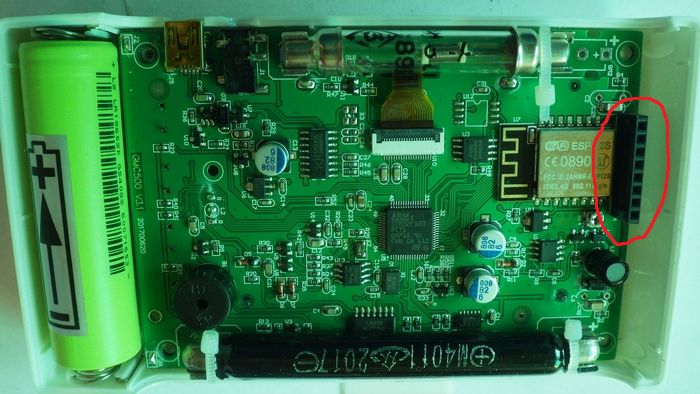
quote:
Originally posted by ullix
GQ has generously supplied me with GMC-500+ counter for testing, and I am running it through its paces.
First I wanted to make sure that GeigerLog supports all the new features, and so far the new GL version 0.9.08 does all of that! (not yet released, but a release candidate can be downloaded from the testing folder on the GeigerLog site, https://sourceforge.net/projects/geigerlog/ )
Not bad for a blind development (well, not quite, because user the_Mike was very helpful with his eyes on his 500 counter, thanks!).
The new case is only slightly larger than that of the old 300 counters, but seems more sturdy and in a more modern design than the old, boxy cases. The buttons are also improved, but I doubt I will ever become a friend of the button concept of the counters. The display is about twice as large and much easier to read, though it does seem to have only the same resolution (dots-per-inch) as the old ones. Which, however, suffices.
The display adjusts itself for proper reading from top to bottom when you hold the counter with its buttons to the left, to the bottom, or to the right - quite convenient. But, strangely, not when the buttons are pointing to the top. (A bug?)
The display shows CPM, CPM1st tube, CPM2nd tube, well readable. CPM is the sum of CPM1st and CPM2nd.
Hmmm. From all possible things one can do with the CPM1st and CPM2nd counts, showing the sum of them is the least meaningful. Even if these were two identical tubes!
My suggestion: scrap the CPM completely and only show 1st and 2nd! Then in a bigger font.
And while you're at it: the unit "Roentgen" had been deprecated some 40 years ago and replaced by Sievert. Is 4 decades not enough for GQ to follow suit? Removing it has the advantage of saving real estate on the display, which could be used for ÁSv/h for the 2nd tube.
I removed the backplate (4 easy screws) and found a surprise:
Image Insert:
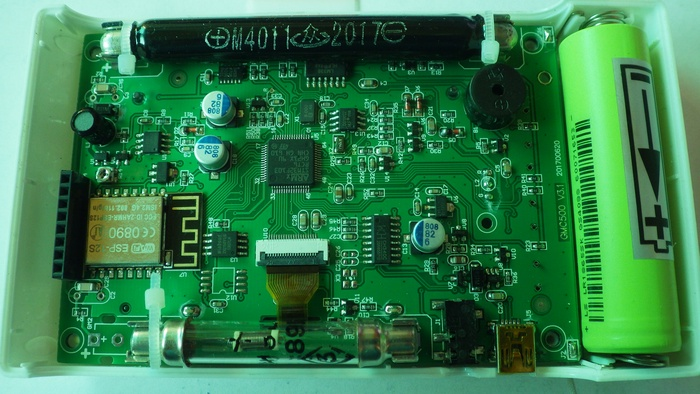
485275 bytes
The M4011 had been a tube of clear glass, and you could see some rainbow colors probably from internally evaporated metals. It is now a tube encased in what seems to be a black plastic cover. Perhaps the consequence of light-sensitivity which I had observed earlier? http://www.gqelectronicsllc.com/forum/topic.asp?TOPIC_ID=4540 Based on limited experiments, so far it does not seem to have a negative impact.
Do other GMC-500(+) owner also have black tubes?
One problem: the name as printed on the tube remains 'M4011'. Be aware of potential confusion when you shop for M4011!
The counter has only a single High-Voltage (HV) generator, so both tubes must live from the same voltage. I used a good Digital Multimeter (6000 counts) with 10MOhm internal resistance and a 1 GigaOhm precision (1%) resistor in series. This means I will measure a voltage, let's say 4.000V, and must multiply with (1000 + 10) / 10 = 101 to get a true voltage of 404V.
I measured a slightly fluctuating voltage of 376...379 V. This voltage is low, even below the recommended operating range according to some websites. For comparison I measured voltage at M4011 of my 300E+ counter and got 395V.
Is below 380V really the intended voltage?
The problem I can see is that with increasing count rate, the current drawn from the HV increases, and due to the high internal resistance of the HV source, the voltage will decrease further. You can see this effect by measuring the voltage without the 1GOhm resistor directly in the 1000V range of the DMM. Instead of 376...379V it will show only 133V; this is normal.
But when you start at the bottom end of the working voltage, any further decrease will get you out of the operating range, which is particularly bad for a device built with a 2nd tube intended for exactly those conditions where it might not work any more?
Please, clarify the situation.
|
 |
|
| Reply #33
Dsl71

Austria
2 Posts |
 Posted - 08/15/2023 : 03:31:42 Posted - 08/15/2023 : 03:31:42


|
Hmm mine looks like this:
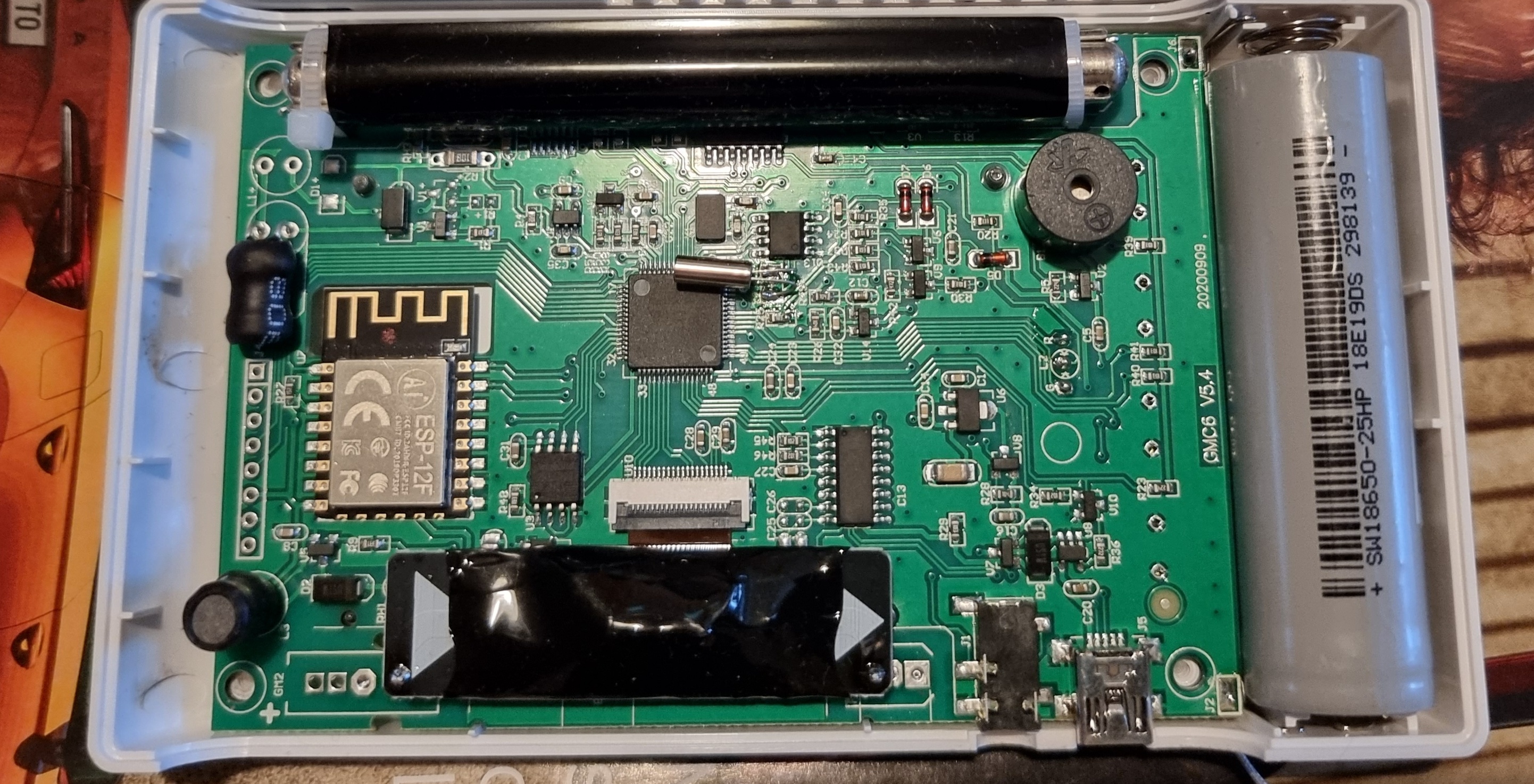
Purchased in 5/2023
It has board revision 5.4 from 20200909. I also have the 600+, it uses the same board revision, only some parts are different. |
Edited by - Dsl71 on 08/15/2023 03:32:59 |
 |
|
| Reply #34
chrism

1 Posts |
 Posted - 08/21/2023 : 03:02:36 Posted - 08/21/2023 : 03:02:36


|
| Same here, Board says GMC6 V5.4 and both tubes seem to be shrink-wrapped somehow. Is there a way for me to identify which tubes are in there? While I assume the shrink wrap protects the glass tubes, will it also shield some of the radiation? |
 |
|
| Reply #35
ullix
    
Germany
1235 Posts |
 Posted - 08/22/2023 : 02:24:23 Posted - 08/22/2023 : 02:24:23


|
The wrapping of the tube is supposed to eliminate the light-sensitivity of these glass tubes. Search in the forum, you will find plenty of light-sensitivity-problems discussions.
You can also look into the GeigerLog manual and read chapter "Appendix H ľ Light Sensitivity of Glass Geiger Tubes" https://sourceforge.net/projects/geigerlog/files/
Yes, that wrapping will take away some of the sensitivity of the tubes. Mainly beta radiation will be affected. But removing the wrapping may result is a useless Geiger unless you also use it during complete darkness ;-))
|
 |
|
 Topic Topic  |
|

